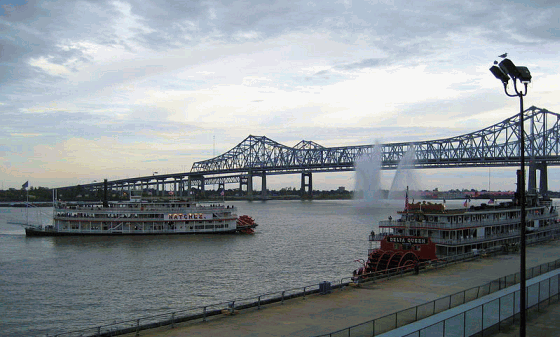|
Today in New Orleans History |
|
|
June 5


 The hull, first two decks, and steam engines of the Delta Quean were ordered in 1924 from the
William Denny & Brothers shipyard on the River Leven adjoining the River Clyde at Dumbarton, Scotland. Delta Queen and
her sister, Delta King, were shipped in pieces to Stockton, California in 1926. There the California Transportation Company
assembled the two vessels for their regular Sacramento River service between San Francisco and Sacramento, and excursions
to Stockton, on the San Joaquin River. At the time, they were the most lavishly appointed and expensive sternwheel passenger
boats ever commissioned. Driven out of service by a new highway linking Sacramento with San Francisco in 1940, the two vessels
were laid up and then purchased by Isbrandtsen Steamship Lines for service out of New Orleans. During World War II, they were
requisitioned by the United States Navy for duty in San Francisco Bay as USS Delta Queen (YHB-7/YFB-56). In
1946, Delta Queen was purchased by Greene Line of Cincinnati, Ohio and towed via the Panama
Canal and the Mississippi and Ohio Rivers to be refurbished in Pittsburgh. In
1948 she entered regular passenger service, plying the waters of the Ohio, Mississippi, Tennessee, and Cumberland
Rivers between Cincinnati, New Orleans, St. Paul, Chattanooga, Nashville, and
ports in between. After a series of different owners, the vessel was most recently purchased from the
Delaware North Companies by the Majestic America Line in April 2006. Besides Delta Queen, the company also owns
the American Queen and Mississippi Queen, larger modern steamboats designed along Delta Queen's
lines. Delta Queen cruised the Mississippi River and its tributaries on a regular schedule, with cruises ranging
from New Orleans to Memphis to St. Louis to St. Paul to Cincinnati to Pittsburgh, and many more.
In some cruises, the vessel probed rivers such as the Arkansas, Red, Tennessee-Tombigbee Waterway,
Black Warrior, Mobile, and more. Delta Queen recreated historic steamboat
races each year during the Kentucky Derby Festival, when she raced with the Belle of Louisville
on the Ohio at Louisville in the Great Steamboat Race. The winner of the annual race received a
trophy of golden antlers, which was mounted on the pilot house until the next race. They also raced
during the Tall Stacks festivals celebrating steamboats, held every three or four years in Cincinnati (Delta
Queen's former home port). On August 1, 2007, Majestic America Line,after loosing a battle involving
fire laws on aged vessels, announced that Delta Queen would cease operations permanently at the end of the 2008 season. In
February 11, 2009, Delta Queen arrived in Chattanooga, Tennessee to become a floating boutique hotel, docked
at Coolidge Park Landing. The Delta Queen Hotel officially opened for overnight guests on June 5, 2009, offering dining,
a lounge, live period music and theatrical performances. Three U.S. Presidents have sailed on Delta
Queen: Herbert Hoover, Harry Truman, and Jimmy Carter. The boat was listed on
the National Register of Historic Places in 1970 and was subsequently declared a National Historic Landmark
in 1989. (WIKI)  

To receive an update for each day in New Orleans
history, join our facebook page
- Today in New Orleans History
Tweet
On Gold June 5, 1991, Harry Connick, Jr's album "20", recorded in his
20th year was certified a Gold Record. It was his second album from Columbia records, but his first album with vocals
(on 6 of 11 tracks), from the label. As with his previous album, he dedicated it "to the memory of my loving mother,
Anita Connick." Banjoist Lawrence (Laurence) Marrero (October 24, 1900 – June 5, 1959) was
born in New Orleans and grew up in a musical family. His brothers were Eddie (bass), John (banjo), Simon (bass), and
their father Billy (bass) were musicians. In 1919 he got his first regular job on banjo with Wooden Joe Nicholas's Camelia
Brass Band and from 1920 he joined on bass drum the Young Tuxedo Brass Band. In 1942 he made the recordings with Bunk Johnson
that started the New Orleans Jazz Revival and he soon became a legend among the Jazz fans. He was featured on many recordings
and was a regular member of the George Lewis band until ill health caused him to quit music in late 1955.
In early 1916 a promoter from Chicago approached clarinetist Alcide Nunez and drummer Johnny Stein about
bringing a New Orleans-style band to Chicago, where the similar Brown's Band From Dixieland led by trombonist Tom Brown already
was enjoying success. They then assembled trombonist Eddie Edwards, pianist Henry Ragas, and cornetist Frank Christian. Shortly
before they were to leave, Christian backed out, and Nick LaRocca was hired as a last-minute replacement. On March 3, 1916
the musicians began their job at Schiller's Cafe in Chicago under the name Stein's Dixie Jass Band. The band was a hit and
received offers of higher pay elsewhere. Since Stein as leader was the only musician under contract by name, the rest of
the band broke off, sent to New Orleans for drummer Tony Sbarbaro, and on June 5, 1916 started playing under
the name, The Dixie Jass Band.(WIKI)
|
|
|

To receive an update for each day in New Orleans history,
join our facebook page - Today in New
Orleans History.
Analytics |


